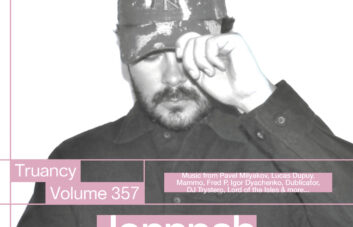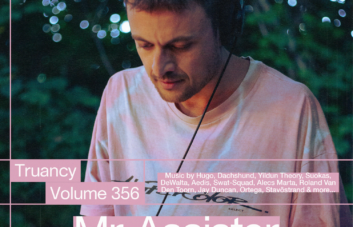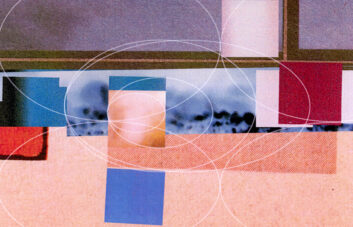For the last eight years, Hamburg-based duo Space Drum Meditation have been steadily carving out their own distinct sonic identity, finding comfort in a sound rooted in ceremonial techno, tribal rhythms and deep atmospheric textures. Their own self-titled label, has become a platform for their productions, having hosted five records, a remix EP, and more recently, their incredible debut album Four Tusks, all wrapped up in a visual style they’ve very much made their own. With Four Tusks, the duo have been able to showcase their ability in turning organic inspiration into immersive soundscapes. The album, heavily shaped by a trip they took to Spain’s Picos de Europa, where they recorded a host of field recordings that included wind whistling through valleys, flowing rivers, and the tolling of bells from roaming horses, sheep, and cows. These recordings became the foundation for a lot of the album’s tracks, anchoring the lush textures of Spain’s northern mountain region with the ritualistic hypnotic undertones techno so often creates.
Beyond their studio work, Space Drum Meditation have cultivated a thriving party series at Berlin’s intimate club Zur Klappe where they’ve hosted a number of contemporary artists that share a similar ethos in pushing techno to new exciting limits. Artists and faves such as Batu, Marco Shuttle, Toma Kami, Konduku, Woody92, and DJ Nigga Fox have all been brought down to play on their lineups. Their live shows are equally celebrated, with the duo offering an electrifying translation of their sound that saw them perform their setup at festivals such as Lunchmeat Festival and Positive Education last year. With this all in mind, bringing them on to our Truancy Volume series for the first mix of 2025 seemed a no brainer, with the pair putting together an extraordinary 90 minute mix of ritualistic, trance-inducing techno.
Hey there! Thanks for answering some questions for us! So how have you both been recently? What’s the year been like for you two so far? Any particular highlights? “It’s been a good year. A lot of time was spent in the studio working on the next records and finishing the debut album, Four Tusks, which was released on November 1st. The live set has also been a focus, where we’ve had lots of fun experimenting and trying out different things with the setup.”
So can you tell us a bit about how the idea for Space Meditation first formed? A lot of those tracks from that first cassette were made over one hot summer correct? I always say a lot of my musical memories are tied to different summers, I imagine this one felt quite special? What else do you remember from that period? “We had our studio above Club Pal when it first opened, in an old atmospheric building between the modern city structures of the fair. On weekends, we rotated between the club and the studio, and we basically lived there during the week, often working into the early morning. We experimented nonstop, recording countless jams. At that time, we were running a mainly house music label called Lehult together with friends of ours, where we then released some of these early works as tapes. Shortly after the tape we started Space Drum Meditation as a record label.”
What’s the process been like in putting out your own music this whole time? I love that you built a great branding design with the records and subsequent merch right off the bat. “When we make music, there’s often a story or scenario that naturally develops, and we try to capture that in the tracks. That vibe then flows into the design as well. From the start, we’ve handled most things ourselves, from the music to the design to the merch. Once we settled on the name, Lars designed the logo, and together we experimented with ideas and techniques for posters and artwork.”

What’s it been like throwing the parties over the years too? I’ve always liked how it’s only usually one guest plus yourselves with long hours to play. Was the simplification of the lineups intentional? Has there been a particular favourite? ” It is about giving our guest the space to fully showcase their sound, allowing the crowd to truly experience it. We like to play a long gradual opening and build up an atmosphere constructed around each guest, creating a journey with a sense of progression. Each night has been unique, and it’s impossible to pick a favorite. Next year, we’ll continue hosting parties at Golden Pudel Club, which has been an institution in Hamburg for countless years, as well as in Berlin (TBA).”
When digging for records, to what extent is your search predetermined? Do you set out with specific styles or artists in mind? Can you easily recall artists or labels while sifting through a stack? What attracts you to a record initially, and how quickly can you discern whether it resonates with you? “When digging together, it’s usually for a specific situation or mood we have in mind. We search for pieces that fit the theme and journey we aim to create, whether it’s grooves, instrumentals, or atmospheres. We also look for a tribal feel in tracks, often with sounds like percussion, vocal chants or flutes. We search for ways to combine different styles and grooves and often layer up to four tracks in our sets.”
So what can you tell us about your recent debut album ‘Four Tusks’? Were these tracks made with an album format in mind with a theme you decided prior? What was the overall process for this like and what sort of new techniques did you learn from it? “All tracks were made specifically for the album, with the theme really taking shape as we worked on the first few pieces. We wanted to create a kind of immersive soundtrack, where each track adds a new layer to the story. We also brought in more real instruments this time, using percussion over drum machines and layering in things like bells, strings, flutes, and our own voices.
During recording, we had a lot of fun experimenting with how we could twist the sounds of the instruments. For example, the darbuka became the hi-hats for ‘Temple of Dusk,’ and a duduk flute line turned into a dark drone on ‘Ritual Destruction.’ A lot of the tracks started from field recordings, and we built from there. When we were making a song, we’d first think about the kind of sound we wanted, then figure out how to get there. For example, if we wanted an acid line, we’d start with a mouth harp, and then later maybe add the TB-303 sound to give it that extra depth. It’s all about experimenting and seeing where it takes us.”
Have you guys always worked in the same studio the entire time? Or has it expanded or moved since your first cassette release from that summer? What sort of routine do you both have? Luckily, we’ve always had a studio together since we started making music, although we’ve had to move a few times. Our first studios were both above clubs, with the second one being above Club Pal, where we recorded the tape. Our current studio is outside the city center, a quieter spot where we have a cat and a more calm vibe which of course influences the music we make.

I’ve been trying something new with the interview format with a couple producers I’ve interviewed in that I’ve been asking if we can break down the making of one of their tracks on a more technical level? One of my favourite tracks from the album is ‘Mistral’, there’s just a very grand scale to it. Can you run us through the track? It’s one of the two tracks on the album where we used a sample. For the melody of ‘Mistral,’ we sampled the Kaba Gaida, a type of bagpipe, in this case played by a hundred musicians simultaneously in the Rhodope Mountains of Bulgaria. As with most of the album tracks, we started with a storyline in mind, which guided the composition. When we found the sample, we felt it could mark a turning point in the album, where the sound expands and new emotions begin to emerge. We recorded the main line throughout the track and then worked on the entire timeline rather than using a loop, adding layer after layer until the full picture took shape. The track features around 40 individual audio tracks, many of which are used to build atmosphere rather than being immediately obvious. For example, the bagpipe sample is layered with a few more synths and a melody on the banjo. A Taiko makes the rhythm and is layered with airy percussion and delay. Especially with a complex track like this, we run many individual stems through the Akai MFC-42 filter. It helps to place recordings within the mix and create dynamic tension through live modulation and LFOs.
To enhance the celestial vibe of the track, we recorded a zither guitar and layered it with a field recording of a herd of sheep, their neck bells echoing through a valley in the Picos de Europa. Named after the Mistral wind, the song tells the story of a healing breeze descending from the mountains. The breath of bagpipe players and echoes of vocal choirs symbolize this wind, while the taiko drum and percussive rhythms evoke the mountains and rubble tumbling into the valley. This wind brings fresh water to cleanse the rivers of toxins, with a sense of melancholy for what drifts away in the current.
How do you evolve as a producer and DJ? What inspires you both, and how crucial is it to challenge yourselves? What does artistic challenge mean to you both, and how do you sustain your love for music? Learning to play new instruments and exploring other art forms has been a big part. We’re not classically trained, which is too bad, but approaching instruments in an amateur way often leads to unexpected and interesting sounds. When preparing our sets, we always create a story in our minds, similar to how we approach making tracks. We like to imagine the place of the party and develop a story told through the music. Being a DJ duo, we have a few more possibilities to add layers and sounds during the mix. Often, we dig for tracks outside of electronic music and blend them together with techno grooves.
How have the live performances gone recently? I saw some clips of what looked like a special show at Lunchmeat Festival in Prague from last year with AV from Aeldryn and Eli Eliasek. Lunch Meat in Prague was good fun and one of the first live shows we did. The crowd and location was amazing and the whole experience was elevated by the visuals from Aeldryn and Eli Eliasek. Was really nice and immersive how light and sound worked together. For these live shows, we used the MPC and a modular system, alongside percussion and flutes played live. Additionally, we used the Korg Wave Drum to add percussion layers. Next year, we will be bringing two different live sets, one for the sweaty club nights and the other in a concert format, which doesn’t quite fit the typical club environment.
Can you tell us about three of you our all-time favourite albums? Forgotten Gods by Suspended Memories—a collaboration between Jorge Reyes, Steve Roach, and Suso Sáiz—is a record that really stands out to us. While each of these artists has brilliant solo albums, this one brings their talents together in a unique way. The blend of tribal grooves, electronic ambients, and shamanic influences from around the world creates a vibe that’s stuck with us. Their ability to combine esoteric instruments with electronic elements feels timeless, sounding somewhere between ancient and futuristic
Another favourite is Vasilisk. They have some incredible albums, but we want to point out “Tribal Zone”. It’s deeply immersive and touching, dealing with Tibet’s occupation. The ritualistic sounds and raw rhythms pull you in.
We also have to mention Joe Claussell and Ron Trent. Their productions have played a huge role in our musical journey. The use of real percussion and tribal notes in house music had pushed us to go more into tribal rhythms.
Mohammad Reza, an Iranian tombak and daf player, we’d also like to recommend. We could see him perform at La Nature Festival in Belgium and at the 99Chats Label Night in Berlin. Watching a master of his craft in action was very inspiring. Check out his album Ritme Jaavdanegi.
The same goes for Huun Huur Tu, a Tuvan group famous for their overtone and throat singing. We saw them live inside an old cargo ship in Hamburg a few years ago, and hearing a human use their voice like that in person was mind-bending and surreal. Check their album Fly, Fly My Sadness, a collaboration with Bulgarian Voices Angelite. The combination of both vocal styles is just perfect.

Could you describe the process of creating this mix? Was there a specific message or feeling you wanted to convey? It’s a more club-oriented approach while still blending in the ritualistic elements of the album. The mix starts with heavy, low rhythms and gradually builds in energy and tempo, before becoming hypnotic and deep, with the idea of creating a trance-like state.
Last, usual question from us, what was the last thing to put a big smile on your face and when was the last time you both had a proper dance? We danced a lot at the three stages of Mo:Dem Festival. We played two sets there, one at a stage called The Swamp and another at The Seed. Then there’s The Hive stage, which is surreal, perched up a hill, a small clearing in the forest filled with massive, detailed installations. It’s an incredible space. The music was fast and super trippy psytrance, perfectly matched by the visual artists bringing the place to life, enhancing both the music and the unique atmosphere of the festival.At this point, a big shout-out to Val, Spekki, and Marco for inviting us and hosting a very special festival!
Space Drum Meditation: Soundcloud, Bandcamp, Instagram
Space Drum Meditation – Four Tusks is now out to buy on all retailers and their Bandcamp.
You can download Truancy Volume 342: Space Drum Meditation in 320 kbps and view the full tracklist on Patreon here. Your support helps cover all our costs and allows Truants to continue running as a non-profit and ad-free platform. Members will receive exclusive access to mixes and tracklists. We urge you to support the future of independent music journalism — a little goes a long way. If you need any IDs though, please leave us a comment on the Soundcloud link and us or Space Drum Meditation will get back to you with the track :)




